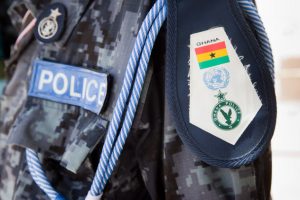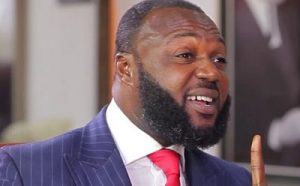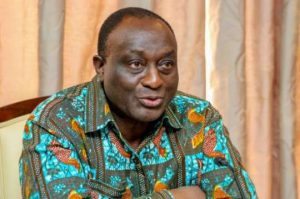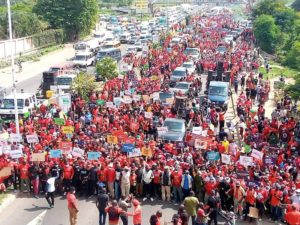A slave trader’s statue in Bristol has been torn down and thrown into the harbour during a second day of anti-racism protests across the UK.
It comes after largely peaceful demonstrations across the weekend saw some clashes with police.
On Sunday evening, police in central London issued a dispersal order for the City of Westminster compelling people to leave the area after skirmishes.
Boris Johnson tweeted that the protests had been “subverted by thuggery”.
Thousands of protesters massed for a second day in London, as well as cities across the UK including Bristol, Manchester, Wolverhampton, Nottingham, Glasgow and Edinburgh.
Protests were generally peaceful, with aerial footage showing thousands of demonstrators flooding the roads outside the US embassy in Vauxhall, south London, before marching towards Parliament Square and Downing Street.
But there were some disturbances, leading to 12 arrests in London – the majority for public order offences and one for criminal damage. Eight officers were injured, police said.
The Metropolitan Police’s Superintendent Jo Edwards said following a “predominantly peaceful protest” in the capital, officers were faced with further “scenes of violence and disorder” which were “entirely unacceptable”.
At around 20:00 BST, bottles were thrown at police and there were clashes near Parliament.
The crowd shouted “no justice, no peace” as they moved down Whitehall and let off smoke bombs.
As darkness fell, lines of police in riot gear took up positions to contain a small group of protesters in Westminster, the BBC’s Tom Symonds said.
A police officer received a head injury and a Section 35 dispersal order was issued until 06:00 on Monday.

The Prime Minister later tweeted: “People have a right to protest peacefully & while observing social distancing but they have no right to attack the police. These demonstrations have been subverted by thuggery – and they are a betrayal of the cause they purport to serve. Those responsible will be held to account.”
Earlier in the day, in Bristol, protesters used ropes to pull down the bronze statue of Edward Colston, a prominent 17th Century slave trader, who has been a source of controversy in the city for many years.
Colston was a member of the Royal African Company, which transported about 80,000 men, women and children from Africa to the Americas.
On his death in 1721, he bequeathed his wealth to charities and his legacy can still be seen on Bristol’s streets, memorials and buildings.
After the statue was toppled, a protester was pictured with his knee on the figure’s neck – reminiscent of the video showing George Floyd, the black man who died while being restrained by a Minnesota police officer.
The statue was later dragged through the streets of Bristol and thrown into the harbour. The empty plinth was used as a makeshift stage for protesters.
Anger, not joy, as slave trader’s statue toppled
Edward Colston: The city divided by a slave trader’s legacy
Slave trader plaque axed in wording row
Home Secretary Priti Patel called the tearing down of the statue “utterly disgraceful”, adding that “it speaks to the acts of public disorder that have become a distraction from the cause people are protesting about”.
“It’s right the police follow up and make sure that justice is undertaken with those individuals that are responsible for such disorderly and lawless behaviour,” she said.
In a statement, Avon and Somerset pPolice confirmed there would be an investigation into the “act of criminal damage”.
Historian Prof David Olusoga told BBC News that the statue should have been taken down long before.
He said: “Statues are about saying ‘This was a great man who did great things.’ That is not true, he [Colston] was a slave trader and a murderer.”
In a statement the Mayor of Bristol Marvin Rees said he knew the removal of the statue would divide opinion but it was “important to listen to those who found the statue to represent an affront to humanity”.
In Parliament Square, the statue of Sir Winston Churchill was sprayed with graffiti, and a Black Lives Matter sign attached – an act described as “stupid and counterproductive” by foreign office minister James Cleverly.
And in Warwickshire, protesters caused the closure of the M6 for around an hour following on from the demonstrations in Coventry city centre.
Thousands join Scottish anti-racism protests
Campaigners rename streets linked to slave owners
Thousands turn out for UK anti-racism protests
It comes after clashes on Saturday night between police and protesters saw missiles and fireworks aimed at police and bikes thrown by some demonstrators.
The Metropolitan Police said 14 officers were injured, including a mounted officer who came off a horse as it bolted down Whitehall.
Met Chief Dame Cressida Dick said she was “appalled” by the scenes of unrest on Saturday night, which led to 14 arrests.
Ms Patel said there was “no excuse for violent behaviour” and said the protests should stop.
However, speaking on Sunday morning, shadow foreign secretary Lisa Nandy backed the demonstrations, saying people “cannot be silent in the face of racism”, but she urged protesters to take precautions and socially distance.
The Labour MP told the BBC’s Andrew Marr she was “proud” of young people demanding change.
Source: BBC






